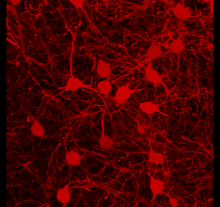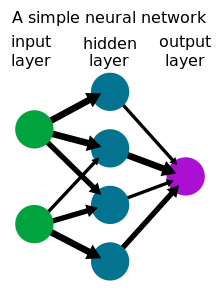Neural network
A neural network is a group of interconnected units called
- In biological neural network is a physical structure found in brains and complex nervous systems – a population of nerve cells connected by synapses.
- In nonlinear functions. Artificial neural networks are used to solve artificial intelligenceproblems.
In biology

In the context of biology, a neural network is a population of biological neurons chemically connected to each other by synapses. A given neuron can be connected to hundreds of thousands of synapses.[1] Each neuron sends and receives electrochemical signals called action potentials to its connected neighbors. A neuron can serve an excitatory role, amplifying and propagating signals it receives, or an inhibitory role, suppressing signals instead.[1]
Populations of interconnected neurons that are smaller than neural networks are called
Signals generated by neural networks in the brain eventually travel through the nervous system and across
In machine learning

In the context of machine learning, a neural network is an artificial mathematical model used to approximate nonlinear functions. While early artificial neural networks were physical machines,[3] today they are almost always implemented in software.
Neurons in an artificial neural network are usually arranged into layers, with information passing from the first layer (the input layer) through one or more intermediate layers (hidden layers) to the final layer (the output layer).[4] The "signal" input to each neuron is a number, specifically a linear combination of the outputs of the connected neurons in the previous layer. The signal each neuron outputs is calculated from this number, according to its activation function. The behavior of the network depends on the strengths (or weights) of the connections between neurons. A network is trained by modifying these weights through empirical risk minimization or backpropagation in order to fit some preexisting dataset.[5]
Neural networks are used to solve problems in
History
The theoretical base for contemporary neural networks was independently proposed by
Artificial neural networks were originally used to model biological neural networks starting in the 1930s under the approach of
See also
- Emergence
- Biological cybernetics
- Biologically-inspired computing
References
- ^ a b
Shao, Feng; Shen, Zheng (9 January 2022). "How can artificial neural networks approximate the brain?". Front Psychol. 13: 970214. PMID 36698593.
- ^
Levitan, Irwin; Kaczmarek, Leonard (August 19, 2015). "Intercellular communication". The Neuron: Cell and Molecular Biology (4th ed.). New York, NY: Oxford University Press. pp. 153–328. ISBN 978-0199773893.
- ^ a b
Rosenblatt, F. (1958). "The Perceptron: A Probabilistic Model For Information Storage And Organization In The Brain". Psychological Review. 65 (6): 386–408. S2CID 12781225.
- ^
Bishop, Christopher M. (2006-08-17). Pattern Recognition and Machine Learning. New York: Springer. ISBN 978-0-387-31073-2.
- ^
Vapnik, Vladimir N.; Vapnik, Vladimir Naumovich (1998). The nature of statistical learning theory (Corrected 2nd print. ed.). New York Berlin Heidelberg: Springer. ISBN 978-0-387-94559-0.
- ^ Bain (1873). Mind and Body: The Theories of Their Relation. New York: D. Appleton and Company.
- ^ James (1890). The Principles of Psychology. New York: H. Holt and Company.
- ^ Hebb, D.O. (1949). The Organization of Behavior. New York: Wiley & Sons.
- ^ McCulloch, W; Pitts, W (1943). "A Logical Calculus of Ideas Immanent in Nervous Activity". Bulletin of Mathematical Biophysics. 5 (4): 115–133. .
